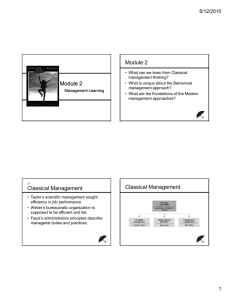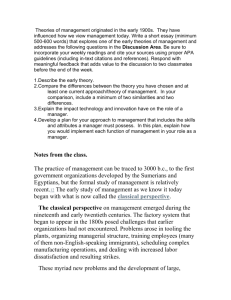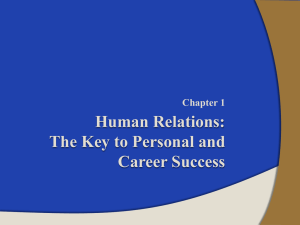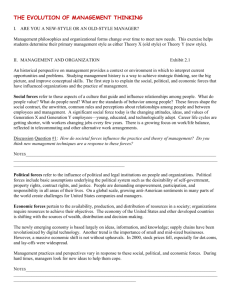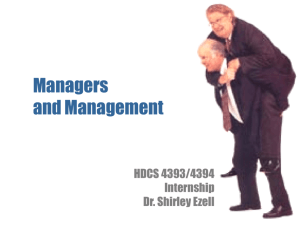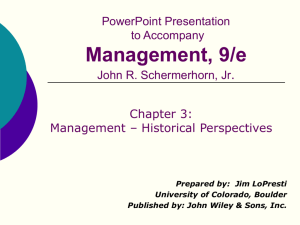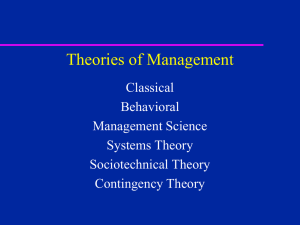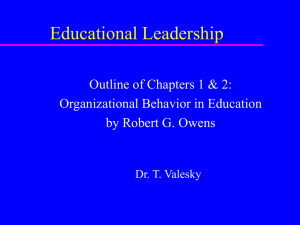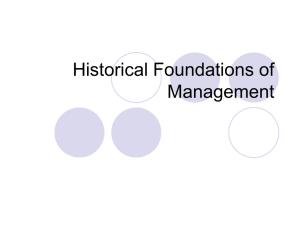Chapter 2 - Personal homepage directory
advertisement
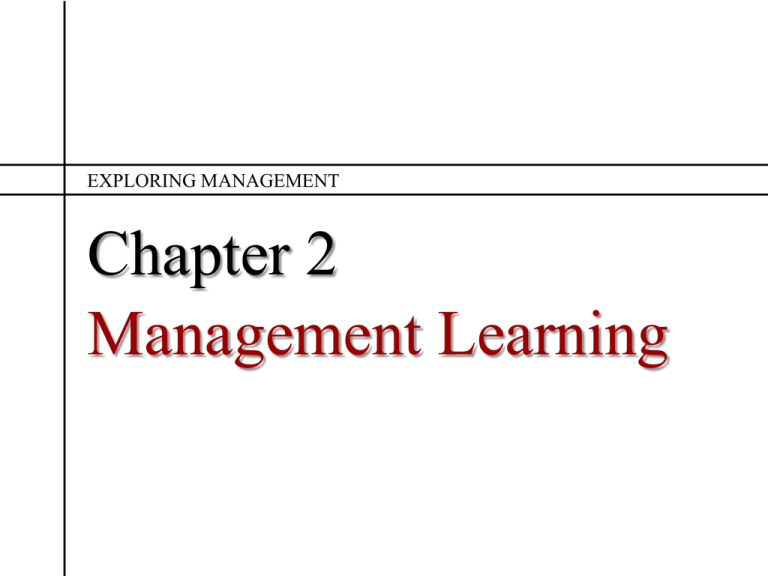
EXPLORING MANAGEMENT Chapter 2 Management Learning Chapter 2 • What are the lessons of the classical management approaches? • What are the contributions of the behavioral management approaches? • What are the foundations of modern management thinking. 2.1 Classical Management • Taylor’s scientific management sought efficiency in job performance. • Weber’s bureaucratic organization is supposed to be efficient and fair. • Fayol’s administrative principles describe managerial duties and practices. Classical Management Please insert the classical approaches graphic from page 32 here. CLASSICAL MANAGEMENT Scientific Management • Frederick Taylor – Wrote The Principles of Scientific Management in 1911. – Believed in finding “maximum prosperity for the employer…and the employee” by identifying the most efficient way to perform tasks. CLASSICAL MANAGEMENT Scientific Management • There is one “best” way to perform any task. • Develop a science for each job. Example: Bricklayers were studied • Hire workers with the right abilities • Train and motivate workers • Support workers by planning and assisting with job science CLASSICAL MANAGEMENT Bureaucracy • Bureaucratic Organizations – Defined by Max Weber in late 19th century – Focused on definitions of authority, responsibility and process – Intended to address the inefficiencies of organizations at that time • Job descriptions were uncommon • Promotions were usually based on personal connections CLASSICAL MANAGEMENT Bureaucracy Characteristics of an Ideal Bureaucracy Clear division of labor • Jobs are well defined, and workers become highly skilled at performing them. Clear hierarchy of authority • Authority and responsibility are well defined, and each position reports to a higher-level one. Formal rules and procedures • Written guidelines describe expected behavior and decisions in jobs; written files are kept for historical record. Impersonality • Rules and procedures are impartially and uniformly applied; no one gets preferential treatment. Careers based on merit • Workers are selected and promoted on ability and performance; managers are career employees of the organization CLASSICAL MANAGEMENT Administrative Principles • Henri Fayol – Published Administration Industrielle et Générale in 1916. – Analyzed and documented the practices of successful managers. CLASSICAL MANAGEMENT Administrative Principles Five Duties of Managers According to Henri Fayol Foresight •complete a plan of action for the future. Organization •provide and mobilize resources to implement plan. Command •lead, select, and evaluate workers. Coordination •fit diverse efforts together, ensure information is shared and problems solved. Control •make sure things happen according to plan, take necessary corrective action 2.2 Behavioral Management • Follett viewed organizations as communities of cooperative action. • The Hawthorne studies focused attention on the human side of organizations. • Maslow described a hierarchy of human needs with self-actualization at the top. • McGregor believed managerial assumptions create self-fulfilling prophesies. • Argyris suggests that workers treated as adults will be more productive. BEHAVIORAL MANAGEMENT Behavioral/Human Resource Approaches Please insert figure 2.1 here BEHAVIORAL MANAGEMENT Organizations as Communities • Mary Parker Follett – 1920’s – Believed that people liked to work in groups and organizations should be communities – Advocated managers and workers work in harmony and employees should own a share of the business – Forerunner of “managerial ethics” and “social responsibility” BEHAVIORAL MANAGEMENT The Hawthorne Studies • Hawthorne Studies – 1924 - 1932 – Lead by Elton Mayo of Harvard – Studies tried to determine how economic incentives and physical environment affected productivity – Involved over 21,000 people – Concluded that human needs were an important factor in increasing productivity BEHAVIORAL MANAGEMENT Hierarchy of Human Needs • Abraham Maslow described human needs and how we try to satisfy them – Lowest level needs are necessary for survival – Progression principle - when one need is satisfied, we proceed on to a higher level need – Deficit principle – satisfied needs don’t motivate behavior BEHAVIORAL MANAGEMENT Hierarchy of Human Needs Please insert figure 2.2 here BEHAVIORAL MANAGEMENT Self-fulfilling Prophecies • Douglas McGregor – Employees react to manager expectations – Managers are separated into two beliefs / styles Theory X Managers • Believe employees generally dislike work, lack ambition, act irresponsibly, resist change and prefer to follow. • Use classical directive “command and control” style Theory Y Managers • Believe employees are willing to work, capable of self control and self direction, responsible and creative • Use behavioral “participative” style BEHAVIORAL MANAGEMENT Personality and Organization • Chris Argyris argues that employees: • want to be treated as adults • will perform better with less restrictive / defined tasks • will behave counter to Scientific & Administrative theories that argue for close supervision 2.3 Modern Management Approaches • Managers use quantitative analysis and tools to solve complex problems. • Organizations are open systems that interact with their environments. • Contingency thinking believes there is no one best way to manage. 2.3 Modern Management Approaches continued… • Quality management focuses attention on continuous improvement. • Evidence-based management seeks hard facts about what really works. MODERN MANAGEMENT APPROACHES Quantitative Analysis • Quantitative Analysis and Operations Research apply mathematical techniques to solve management problems such as – Forecasting sales or expenses – Establishing optimal levels of inventory – Reducing labor costs without sacrificing customer service MODERN MANAGEMENT APPROACHES Quantitative Analysis • Operations Management – Producing goods and services efficiently and effectively, including • • • • • Improving processes and operations Effective workflow designs Project management Inventory management Quality control MODERN MANAGEMENT APPROACHES Open Systems Please insert figure 2.3 here MODERN MANAGEMENT APPROACHES Subsystems • Subsystems are a smaller part of a larger system. Please insert figure 2.4 here MODERN MANAGEMENT APPROACHES Contingency Thinking • Contingency thinking – The best way to manage depends on the circumstances. – Environmental uncertainty – Technology – Organizational structure – Employee abilities MODERN MANAGEMENT APPROACHES Continuous Improvement • W. Edwards Deming – early advocate of quality control – Taught quality control techniques to Japanese industry in the 1950s – Rediscovered by U.S. industry in the early 1980s MODERN MANAGEMENT APPROACHES Continuous Improvement • Deming’s principles Tally defects Analyze and trace them to the source Make corrections Keep a record of what happened MODERN MANAGEMENT APPROACHES Continuous Improvement • Total quality management – Organization-wide commitment to quality products or services. • Continuous improvement – Always looking for new ways to improve. MODERN MANAGEMENT APPROACHES Evidence-based management • High-performance organizations – High performance operations – High quality work life • Evidence-based management – Uses data from extensive research to determine what practices really work well – Challenges conventional wisdom

